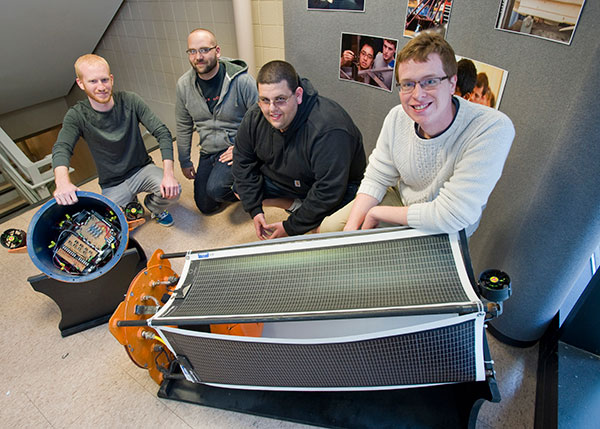December 08, 2014,

CARBONDALE, Ill. -- Embedded systems, environments that use embedded microprocessors to control systems and provide feedback in real time, are everywhere. And they have a special place at Southern Illinois University’s College of Engineering.
SIU is home to the Center for Embedded Systems, a national consortium of electronics research funded by the National Science Foundation. The center is a joint effort among SIU’s College of Engineering, the Fulton School of Engineering at Arizona State University and private industry, said Spyros Tragoudas, professor and chair of the Department of Electrical and Computer Engineering and leader of the effort at SIU.
“More and more, our world is driven by electronics and electronic control systems,” Tragoudas said.
Created in 2009, the center remains the only one of its kind funded by NSF in the nation. Other universities that wish to conduct research in this area can join the center if they meet the requirements.
The center is aimed at finding new algorithms, applications and designs for new levels of sophistication, and sharing those advances with commercial vendors and others. Its researchers are designing, testing and dreaming of the embedded systems of tomorrow.
Acting as a sort of nervous system for technological and advanced mechanical systems, embedded systems see, hear, feel, communicate, think and adjusting operations for maximum efficiency.
They are in everything, from car emissions to cell phone networks and environmental controls systems. They are at work in manufacturing, airliners and defense systems.
Researchers at SIU investigate issues ranging from finding ways to achieve and maintain access to the microprocessors, to testing and verifying their reliability. They also work on the design, size and weight of such microprocessors, which may be critical based on their intended applications.
The consortium has many partners in industry, who pay an annual fee for membership in the consortium and sit on its advisory board. The members of the board select proposed research projects for funding. The consortium provides industry partners with an array of experts in the fields of electrical and computer engineering and science,
Since its beginning, the center has worked with scores of industry partners, such as Caterpillar, Intel, Johnson Controls and many others. Center researchers work together with companies to identify emerging applications for embedded systems. Researchers then work with industry to develop research proposals based on those needs.
Researchers work on issues of reliability and speed of microprocessors, as well as their power consumption, among other things, Tragoudas said.
“So (the industry partners’) needs have to match our expertise,” he said.
Student researchers also play an important role.
Last year, the center spent $350,000 on research efforts, funded by industry partners, the NSF and the university. Industry partners also give some money to develop specified courses of study for students, while NSF also funds some fundamental research related to embedded systems technology.
Tragoudas said the center is applying for additional “stage II” funding from the NSF, which would add another five years to the original funding.
“With that we will be trying to get additional and larger corporate partners; those that have sustainable research efforts in their structure, to work with,” he said.
The center also may play a large role in a recently announced federally funded initiative aimed at assisting the manufacturing sector. The Center for Embedded Systems, along with SIU’s Materials Technology Center, will coordinate the effort announced Feb. 25 by President Obama.
Under this effort, a multi-partner team led by UI LABS in Chicago will receive a $70 million award from the Department of Defense for the Digital Manufacturing and Design Innovation Institute. The long-term goal of the institute is to make American manufacturing more competitive on the global stage.
Along with the defense department funding, industry, the university and the government will supply another $250 million to UI LABS to form the $320 million digital lab. SIU, a partner in the collaborative, could have opportunities to conduct applied research in the areas of advanced materials, digital manufacturing and embedded systems
Tragoudas said the specifics of SIU’s role are still being worked out. Researchers at both the Carbondale and Edwardsville campuses could be involved, however.
“Digital manufacturing is very related to what we do here, and we have the technical experts who could be involved in certain aspects,” Tragoudas said. “We will be involved, but the roles have not yet been defined and the magnitude of our involvement or the amount of money we might receive is not yet known.”
Tragoudas said the center is another way SIU serves the community and the larger world around it.
“At the end of the day, the center helps make SIU more visible,” Tragoudas said. “It really puts us on the map.”